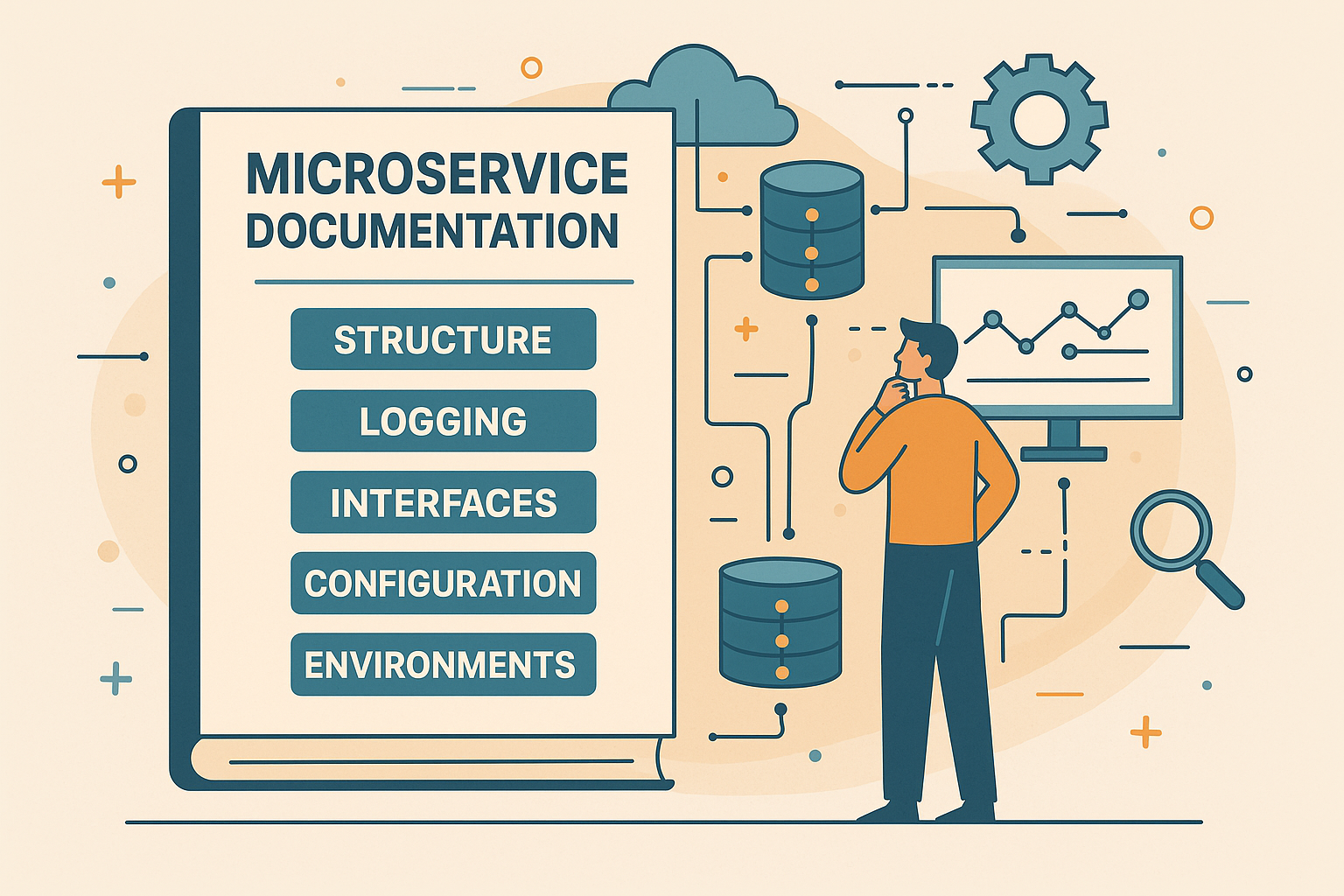How to Document a Microservice Using the SLICE Framework — So Well That Teams Reuse It Without Asking
Struggling to document your microservices clearly? Learn how to use the SLICE framework to write docs your teammates will thank you for. Real example. Real impact. Internal reuse guaranteed.

Whether you're onboarding a new developer, handing over services, or preparing for interviews — your ability to document microservices clearly and completely is what separates amateurs from real pros.
This article introduces the SLICE framework — a simple, repeatable format that works beautifully for internal documentation, team onboarding, and even resumes and recruiter portfolios.
We'll walk through a real-world example: a microservice named ShipmentService, and show exactly how to document it using SLICE.
📦 The Microservice Example: ShipmentService
Before we apply SLICE, here's what ShipmentService does:
- It's part of an e-commerce or supply chain platform.
- It manages shipment creation, tracking, and updates.
- It integrates with:
- Inventory API to check stock before shipment
- Kafka to publish shipment events to other systems
- Datadog for logs and metrics
- PostgreSQL as the primary data store
- Jenkins for CI/CD deployments
- It has retry logic for Kafka sends, uses feature flags, and is deployed across staging and production.
Let’s now walk through how to document this using SLICE.
🧩 S – Service Overview
What does this service do, and why does it exist?
This section sets the stage for understanding the purpose of the service. Skip the buzzwords. Be direct, yet informative.
🎯 Goal
The ShipmentService is responsible for creating, tracking, and updating shipment records for orders.
🔁 Core Flow
- Accepts shipment creation requests from OrderService.
- Validates item availability by querying Inventory API.
- Saves shipment info to PostgreSQL DB.
- Publishes
shipment.created,shipment.updatedevents to Kafka. - Emits metrics/logs to Datadog for observability.
📌 Why This Matters
This service decouples shipping logic from order processing, allowing independent scalability, better retries, and clean event-based workflows.
🧱 L – Logic + Lifecycle
What happens when the service runs? Describe the actual code flow, states, retries, timeouts, etc.
This is the section where many docs go vague. You need to be specific here.
🧠 Core Logic
POST /shipmentsAPI endpoint is triggered by OrderService.- Validates request payload and fetches item data from Inventory API.
- If inventory is insufficient, it returns
409 Conflict. - Creates a shipment DB entry and assigns tracking ID.
- Publishes event to Kafka topic
shipment.created.
🔁 Retry & Resilience
- Kafka publishing uses retry logic with exponential backoff (max 3 retries).
- Any transient DB failure also triggers a retry.
- Circuit breaker pattern used for external API calls (Inventory).
🧭 Lifecycle
- Each shipment moves through these states:
CREATEDDISPATCHEDIN_TRANSITDELIVEREDFAILED
These transitions are driven by events from logistics partners.
📡 I – Integration Points
What does this service depend on? Who depends on it? What protocols are used?
You must name real systems, protocols, and failure expectations. This gives clarity to both devs and SREs.
📥 Incoming Dependencies
OrderServicecallsPOST /shipments- Logistics partners send updates via webhook
📤 Outgoing Calls
- Inventory API (HTTP REST)
- Endpoint:
GET /inventory/{itemId} - Auth: JWT
- Retry: Yes
- Endpoint:
- Kafka Topics
shipment.createdshipment.statusUpdated- Publisher uses
kafka-node
🔁 Internal Shared Libraries
- Auth token validator
- Kafka producer wrapper (with retry)
🤝 Used By
NotificationService(consumesshipment.createdevents)TrackingUIfrontend (queries shipment status)
🌐 Environment Details
- Runs on Kubernetes cluster
shipping-prod-cluster - Configs via
envvariables andConfigMap - Deployed via Jenkins CI/CD (staging + prod)
🛠 C – Configuration + CI/CD
What are the critical configs, env setups, toggles, and deployment mechanisms?
This helps new devs avoid guesswork and reduces onboarding time.
🔧 Config Variables
INVENTORY_API_URLKAFKA_BROKER_URLDB_URLLOG_LEVELFEATURE_SHIPMENT_PARTNER_X_ENABLED
🎚 Feature Flags
FEATURE_ENABLE_SPLIT_PACKAGINGFEATURE_ENABLE_KAFKA_RETRY- Controlled via LaunchDarkly
📦 CI/CD
- Jenkins Pipelines
build -> test -> lint -> dockerize -> deploy- Envs:
dev,staging,production
- Helm Charts used for deployment
- Rollbacks supported via Jenkins UI
🔍 Observability Setup
- Logs go to Datadog using sidecar logger
- Key metrics:
shipment_created.countshipment_failed.countkafka_publish_retry.count
- Dashboards available in team Datadog workspace
- Alerts for Kafka failures and DB spikes
🪢 E – Edge Cases + Errors + Evolution
What can go wrong? What was learned from prod issues? What should future devs watch out for?
This section builds team memory and reduces repeat failures.
🧨 Known Errors
- Inventory API returns 500 → leads to failed shipments.
- Fix: Circuit breaker now added.
- Kafka producer timeout caused lost events.
- Fix: Retries + Alert added.
- Jenkins deploy failure due to broken Helm chart.
- Fix: Pre-deploy lint + chart tests.
🔁 Edge Scenarios
- Duplicate shipment creation requests from OrderService.
- Dedup logic now added based on order ID.
- Logistics sends invalid webhook payload.
- Now validated using schema.
- Inventory API changes contract.
- Contract test now part of CI.
🧬 Evolution Plans
- Add
shipment.cancelledsupport - Introduce GraphQL endpoint for frontend
- Migrate from PostgreSQL to CockroachDB
📈 Career + Company Benefits
👨💻 For Developers
- Shows maturity in thinking through real-world behaviour
- Gives clarity to future readers or collaborators
- Looks impressive during KT, reviews, and interviews
🧠 For Architects
- Makes integration easier across teams
- Promotes documentation culture without jargon
- Enables system thinking in design and handovers
🏢 For Companies
- Faster onboarding
- Fewer repeat outages
- Reliable service knowledge — even if people leave
🎯 Final Thoughts
The SLICE framework is simple, but powerful. Most internal service docs are either too vague or too noisy. This structure balances clarity with completeness.
Sgives the WHYLgives the HOWIshows the CONNECTIONSCreveals the SETUP & DEPLOYMENTEshares the SCARS & FUTURE
Start documenting your services using SLICE. Share it with your team. Add it to your onboarding. Use it in interviews.
And if you're reading this as a hiring manager —
Wouldn’t you want this kind of clarity in your team?
✅ Want more frameworks like SLICE?
I share weekly articles on thetruecode.com
Where tech writing meets real-world dev life.

